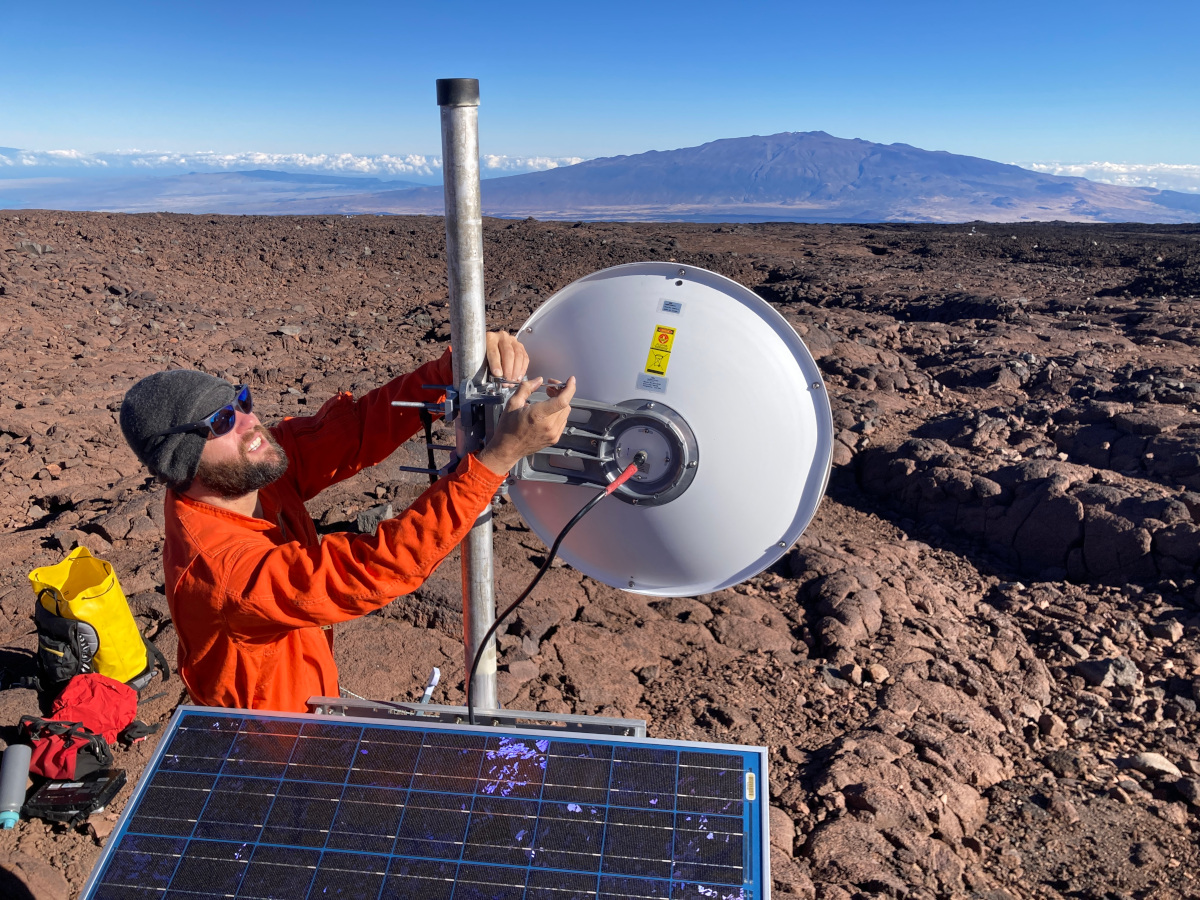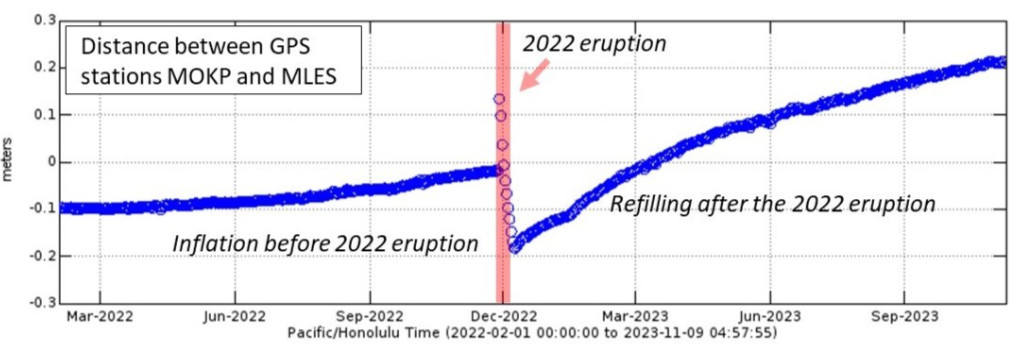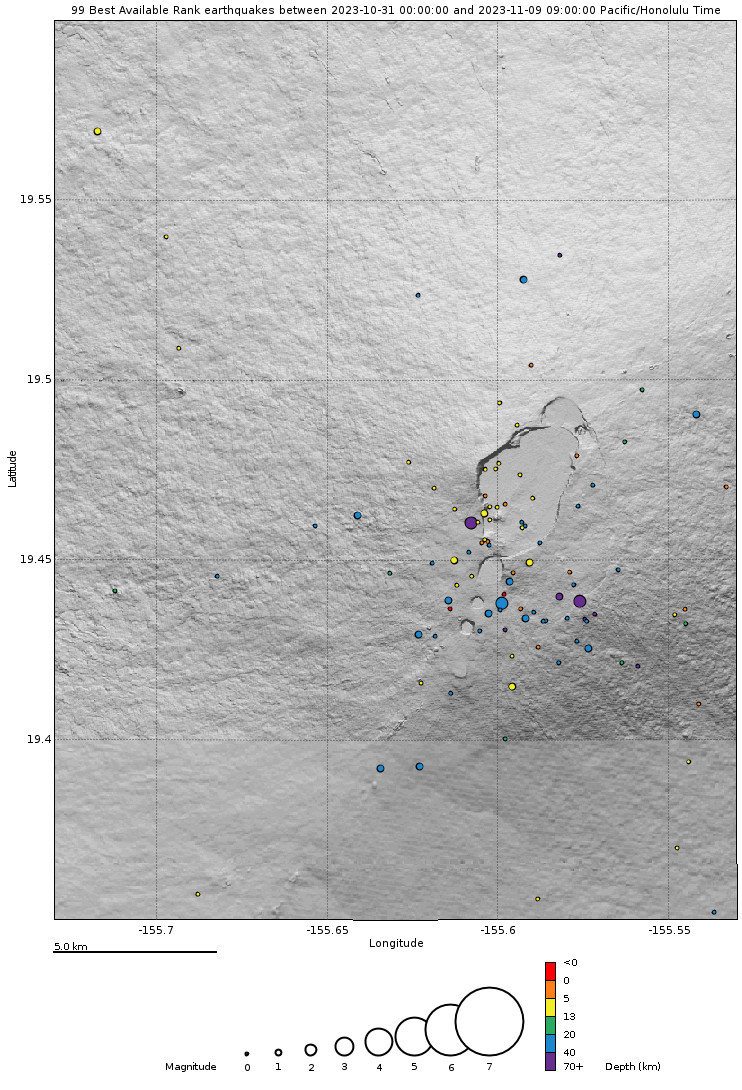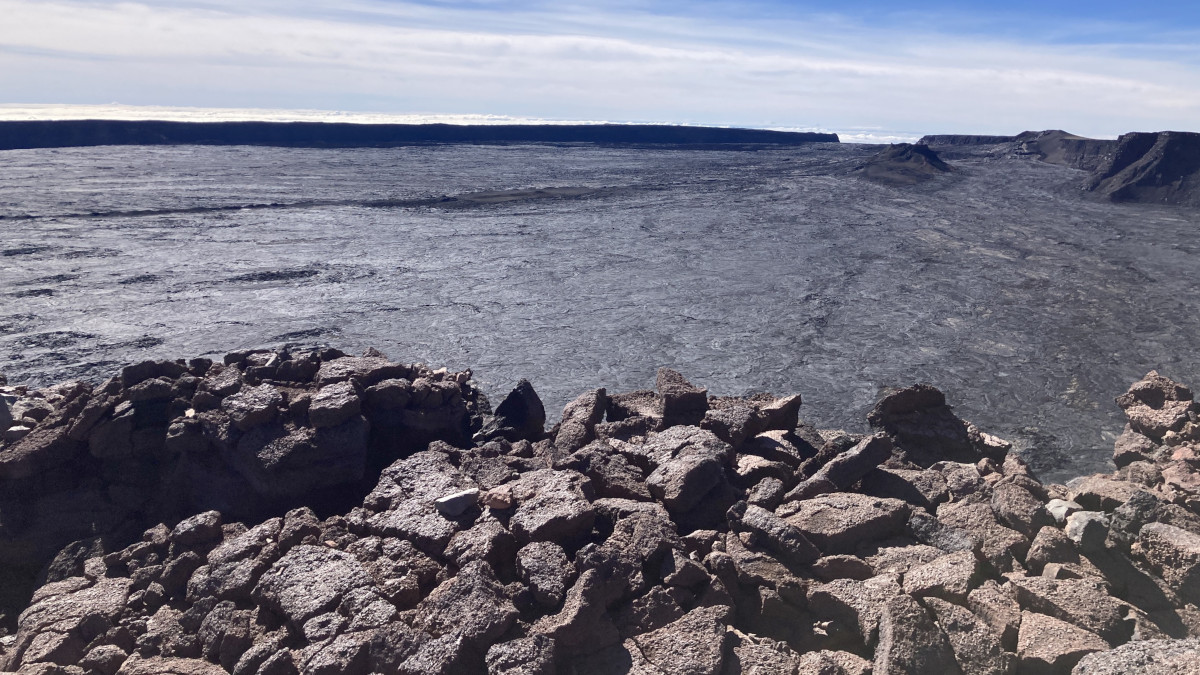
USGS: “On November 8, 2023, Hawaiian Volcano Observatory (HVO) staff visited the rim of Moku‘āweoweo (Mauna Loa’s summit caldera) to service the MLcam and the MTcam. In this photo, an HVO technician adjusts the antenna that transmits the webcam data back to the observatory.” (USGS photo by M. Patrick)
(BIVN) – Mauna Loa volcano is not erupting and the USGS Alert Level remains at NORMAL
From this week’s Volcano Watch article, written by U.S. Geological Survey Hawaiian Volcano Observatory scientists and affiliates:
It’s hard to believe that nearly one year has passed since Mauna Loa erupted. Mauna Loa has been mostly quiet since the end of the 2022 eruption, but a small increase in seismic activity in late October 2023 reminds us that the volcano remains active.
The 2022 event was significant in that it occurred following the longest noneruptive period—38 years—at Mauna Loa in the past two centuries. Like most Mauna Loa eruptions, the 2022 eruption started in Mokuʻāweoweo (the summit caldera). Within hours, activity moved into the Northeast Rift Zone, generating lava flows primarily in a north/northeast direction that crept to within 3 km (2 mi) of the Daniel K. Inouye Highway.
Following the 2022 eruption, Mauna Loa quickly began to reinflate, indicating that magma continued to be supplied to the volcano’s magma chamber. This observation is not unprecedented, as ground deformation rates on Mauna Loa were similarly high following the 1975 and 1984 eruptions, but eventually declined to background levels before the next volcanic unrest. In the months following the 2022 eruption, the deformation rates have slowly declined, though they remain relatively high.

USGS: “Plot showing the distance between two GPS stations on Mauna Loa from February 2022 to November 2023. Station MOKP is on the north side of Mokuʻāweoweo and station MLES is east of Mokuʻāweoweo. This plot shows how the distance between these two stations increased before the 2022 Mauna Loa eruption, indicating that the volcano was inflating. In the months following the 2022 eruption, the deformation rates have slowly declined, though they remain relatively high.” (USGS plot)
New seismic observations over the past month include more frequent occurrences of signals associated with magma movement. Most of these signals have occurred at depths of 40–60 km (25–37 mi) beneath Mokuʻāweoweo, though some have occurred at shallower depths within 16 km (10 mi) of the ground surface. These observations are also not unprecedented: similar signals at deep depths occurred during 2002 and 2004.
In the decades prior to the 2022 eruption, Mauna Loa exhibited several periods of prolonged and increasing unrest. Over the past week, the number of seismic events has decreased, but the rate of ground deformation remains high. If Mauna Loa seismic activity becomes more persistent—in combination with elevated rates of ground deformation—this may herald a shift back into a period of unrest.

USGS: “Map showing the locations of earthquakes beneath Mauna Loa between October 31, 2023, and November 9, 2023. The earthquake colors indicate their depth. Most earthquakes have occurred at depths of 40–60 km (25–37 mi) beneath Mokuʻāweoweo, though some have occurred at shallower depths within 16 km (10 mi) of the ground surface.” (USGS map)
Mauna Loa’s most recent eruptions in 2022, 1984, 1975, and 1950 have occurred years to decades apart. However, prior to 1950, Mauna Loa erupted more frequently. Only three Mauna Loa eruptions occurred in the second half of the 20th century, but twelve eruptions occurred in the first half of the century.
Mauna Loa eruptions have varied in duration. The 1949 summit eruption, for example, lasted nearly five months; this was soon followed by the 1950 Southwest Rift Zone eruption that lasted several weeks, generating lava flows that swiftly descended steep slopes in South Kona to enter the ocean within a few hours of the eruption onset.
Considering the past eruption patterns and current monitoring observations, is Mauna Loa entering another prolonged period of variable unrest like it had in the decades preceding the 2022 eruption? Alternatively, is the volcano entering a phase of more frequent eruptions like it had prior to 1950?
While the recent observations on Mauna Loa are not alarming, they are certainly thought-provoking. Contextualizing these observations relative to past eruptions is difficult because the unrest and subsequent run-up to the most recent eruption were monitored with a denser and more modern equipment network compared to those previous. In the months prior to the 2022 eruption, USGS Hawaiian Volcano Observatory (HVO) staff were comparing earthquake activity to paper records from 1984, as well as comparing the tilt and GPS readings to relatively sparse ground deformation surveys from the years following the 1975 and 1984 eruptions.
Although Mauna Loa’s USGS volcano alert level and aviation color code have remained at NORMAL/GREEN since the eruption ended last year, the volcano remains active and will erupt again in the future. HVO will continue to keep a close eye on Mauna Loa’s monitoring data, watching for additional signs that might indicate the volcano is entering a period of elevated unrest.


by Big Island Video News8:00 am
on at
STORY SUMMARY
HAWAIʻI ISLAND - Mauna Loa summit seismicity has increased slightly in the past month, scientists say, while slow inflation indicates magma is replenishing the reservoir system following the 2022 eruption.